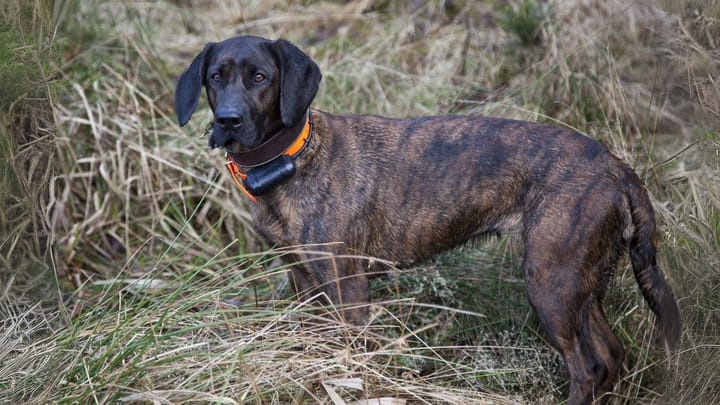Hanoverian Scent Hound
Other names : Hanover Hound, Hanoverian Hound, Hannoverscher Schweisshund


The Chien rouge de Hanovre, or Hanover Red Dog, is a bloodhound that can be traced all the way back to medieval times. It has been used as a tracking hound for hundreds of years. The Hanover Red Dog remains a very rare breed. It’s still very much a working dog and is unaccustomed to the domestic life of the household dog. They prefer living in packs and should only be kept as pets by owners who live in or near the countryside.
|
Life expectancy |
The Hanoverian Scent Hound has a life expectancy of between 11 and 13 years |
|
Temperament |
|
|
Size |
Medium
|
|
Adult size |
Female
Between 19 and 21 in
Male
Between 20 and 22 in
|
|
Adult weight |
Female
Between 55 and 77 lb
Male
Between 66 and 88 lb
|
|
Coat colour
Red or dark brown. |
Red Sand |
|
Type of coat
Short, flat, tight to the body. |
Short |
|
Eye colour
Dark brown. |
Brown
|
The Hanover Red Dog is a very rare breed. Potential owners will need to contact a specialist breeder. Hanover Red Dogs are usually imported into the UK. This can be very expensive.
He has an exceptionally high-prey drive, even for a scenthound, and can become single-minded once he catches a scent. He also needs to be exercised in the countryside, and will quickly get bored and frustrated if kept on the leash. Since he is still a real working dog, he may not be suited to domestic life.
More details about the Hanoverian Scent Hound
Hanoverian Scent Hound: Origins and history
Scenthounds can be traced all the way back to the Middle Ages, but the modern breeds were developed in the 18th century. Unsurprisingly, the Hanover Red Dog was developed in the Hanover region of Germany. The Hanover red dog is primarily used to track big game, such as deer and elk. They were designed to thrive in mountainous regions and are not really suited to urban living.
Physical characteristics of the Hanoverian Scent Hound
The Hanover Red Dog is medium sized and well proportioned, with a lean and muscular torso, a wide, deep chest and slightly wrinkled forehead. His eyes are deep and lively, so as to give a severe expression. His medium-length ears are broad and attached high, smooth and not coiled, hanging by the head. His tail is long and slightly curved, held high, robust and tapered towards the tip.
FCI classification of the Hanoverian Scent Hound
-
Group 6 - Scent hounds and related breeds
-
Section 2 : Leash (scent) Hounds
Hanoverian Scent Hound: Characteristics
Hanoverian Scent Hound: Behaviour
Training a Hanoverian Scent Hound
This is not the easiest dog to educate due to his hunting and guarding instincts. He must be trained firmly and with kindness from puppyhood.
Hanoverian Scent Hound: Lifestyle
Breed compatibility Hanoverian Scent Hound
Hanoverian Scent Hound: Purchase price
We do not have enough data to set an average price. However, looking after a dog of this size typically costs between £150 to £190 a month, including food, medical/insurance, and incidental expenses.
Hanoverian Scent Hound: Shedding
Average
Very low shedding.
Hanoverian Scent Hound: Grooming
Minimal grooming requirements. A weekly brush will keep his short coat clean and healthy.
Hanoverian Scent Hound: Health
A well-bred animal. Generally very healthy, but prone to ear infections. It's average life expectancy is 12 years.
This is a strong, sturdy dog with a muscular body. He is well-balanced and agile, and physically and mentally tough.
His short, tight coat helps keep him cool during the summer months, but beware of heat stroke during heat waves.
He can sleep outside, but might struggle during the coldest times of the year. He will need a coat for winter-time walks.
He has a modest appetite, and no issues with weight gain or obesity.
- Dental issues
- Skin infections
- Eye disorders
- Ear infections
Do you want a Hanoverian Scent Hound dog ?
Oh no...
There are no Hanoverian Scent Hound adoption profiles at the moment...






